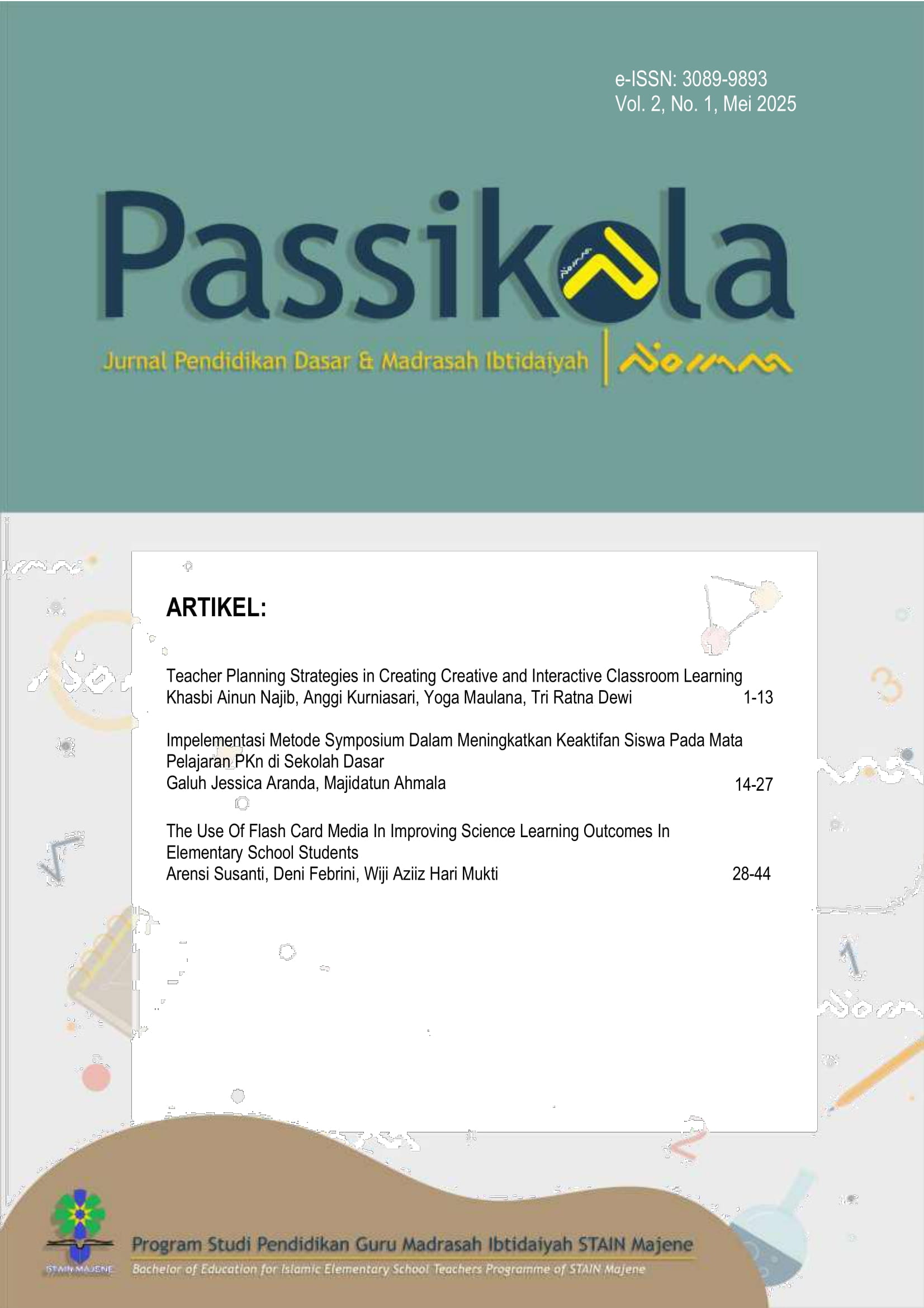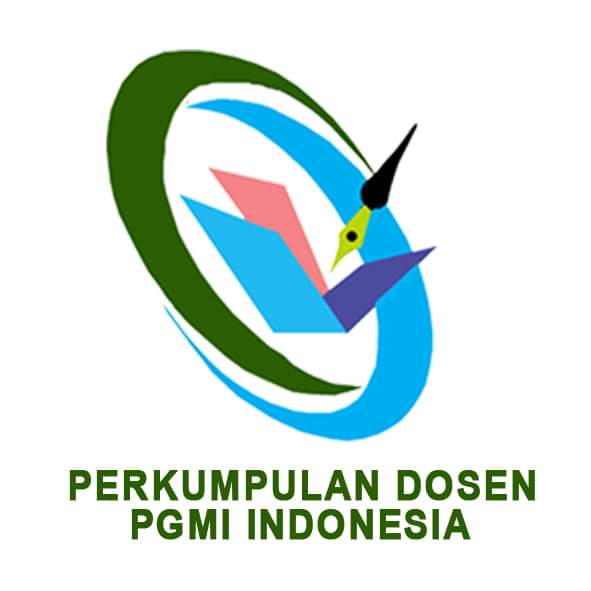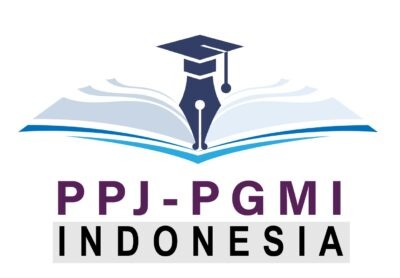The Use Of Flash Card Media In Improving Science Learning Outcomes In Elementary School Students
DOI:
https://doi.org/10.46870/passikola.v2i1.1592Keywords:
Usage,, Flash Card Media,, Improving Learning Outcomes,, Science, , Elementary School Students,Abstract
This study aims to determine the use of flash card media in improving science learning outcomes of grade IV students at SDN 09 Kepahiang. This study is a quantitative research with a Quasi Experimental design that aims to test the effectiveness of Flash Card media on the science learning outcomes of grade IV students of SDN 09 Kepahiang. The study involved two groups an experimental group using a Flash Card and a control group using conventional learning methods. The sample consisted of 40 students who were selected purposively, 20 students each in grades IV A and IV B. Data was collected through observation, documentation, and tests in the form of pre-test and post-test. The research instrument was in the form of multiple-choice questions that had been tested for validity (21 valid questions out of 25), reliability (coefficient of 0.758), and difficulty level (the majority of questions were classified as easy to moderate). Data analysis began with a prerequisite test in the form of normality (Chi-Square) and homogeneity (F-test) tests, then continued with hypothesis tests using independent sample t-tests. The results of the analysis aimed to determine the significance of the difference in learning outcomes between students who learned using Flash Cards and those who did not. The findings in the study are that the use of Flash Card media is significantly effective in improving the learning outcomes of science subjects for grade IV students. This is shown by an increase in the average posttest score of the experimental class by 37.75 points to 82.25, which is higher than that of the control class which only increased by 28.5 points with an average of 71.75. The t-test showed statistically significant results (t count = 3.441 > t table = 2.021 at 5%), confirming that the difference in learning outcomes between the two classes did not occur by chance. Flash Cards are proven to help students understand abstract and factual concepts of science through attractive visual presentations and the use of keywords that make it easy to remember. In addition, the interactive nature of this media also increases students' active involvement in the learning process. Thus, Flash Cards not only play a role as a tool, but also as an effective learning strategy in improving the quality of science education at the elementary school level.
References
Abraham, I., & Supriyati, Y. (2022). Desain Kuasi Eksperimen Dalam Pendidikan: Literatur. Jurnal Ilmiah Mandala Education, 8(3). http://dx.doi.org/10.58258/jime.v8i3.3800
Ali, A., Maniboey, L. C., Megawati, R., Djarwo, C. F., & Listiani, H. (2024). Media Pembelajaran Interaktif: Teori Komprehensif dan Pengembangan Media Pembelajaran Interaktif di Sekolah Dasar. PT. Sonpedia Publishing Indonesia.
Ansya, Y. A., & Salsabilla, T. (2024). Model Pembelajaran IPA di Sekolah Dasar. Cahya Ghani Recovery.
Arief, M. M. (2021). Media Pembelajaran IPA di SD/MI (Tujuan Penggunaan, Fungsi, Prinsip Pemilihan, Penggunaan, dan Jenis Media Pembelajaran). Tarbiyah Darussalam: Jurnal Ilmiah Kependidikan Dan Keagamaan, 5(1). https://jurnal.iaidarussalam.ac.id/index.php/tarbiyah/article/view/33.
Arsyaf, F., Usman, H., Aunurrahim, M., & Yulianingsih, S. (2022). Pengembangan media pembelajaran e-Flashcard berbasis website untuk pembelajaran IPA SD. Jurnal Pendidikan Dan Kebudayaan (JURDIKBUD), 2(3), 349–357. https://doi.org/10.55606/jurdikbud.v2i3.756
Badaruddin, S. (2024). Cara Menangani Siswa SD/MI Yang Memiliki Kemampuan Pengetahuan Yang Bervariasi. Passikola: Jurnal Pendidikan Dasar & Madrasah Ibtidaiyah, 1(1), 1–15. https://jurnal.stainmajene.ac.id/index.php/pgmi/article/view/1197.
Badaruddin, S., Muhkam, M. F., Syajida, N., & Nurmaida, N. (2024). The Influence of Active Learning By Integrating Religious Moderation Values On PPKN Learning Outcomes By Students. JED(Jurnal Etika Demokrasi), 9(2), 134–144. https://doi.org/10.26618/jed.v9i2.12851
Bruner, J. (1999). Folk pedagogies. Learners and Pedagogy, 1(1), 4–20.
Cahyanto, B., Badaruddin, S., Rini, T. A., Kamarzaman, M. H., & Syafuddin, A. (2024). Internalization of the Pancasila and Rahmatan Lil Alamin Student Profiles Dimensions in the Implementation of the Merdeka Curriculum in Madrasah Ibtidaiyah. Cendekia: Jurnal Kependidikan Dan Kemasyarakatan, 22(2). 10.21154/cendekia.v22i2.9906
Cahyanto, B., Majid, D., Badaruddin, S., Dewi, Q. R. T., Oktaviani, E., & Saleh, H. (2024). Outdoor Learning in Elementary Schools: Utilizing the Surrounding Environment to Increase Student Learning Engagement. Jurnal Pemikiran Dan Pengembangan Sekolah Dasar (JP2SD), 12(2), 245–258. https://doi.org/10.22219/jp2sd.v12i2.33364
Dale, E. (1969). Audiovisual methods in teaching.
Dewi, P. S. (2018). Peta Konsep Sebagai Pendukung Pembelajaran dalam Memahami Pengetahuan Konsep Dasar IPA untuk Calon Guru Sekolah Dasar. Terampil: Jurnal Pendidikan Dan Pembelajaran Dasar, 3(2), 181–203. https://doi.org/10.24042/terampil.v3i2.1195
Fuadhi, A. R., Suhartono, S., & Rokhmaniyah, R. (n.d.). Penerapan Model Problem Based Learning (PBL) dengan Media Flash Card untuk Meningkatkan Hasil Belajar IPAS di Kelas V SD Negeri III Ngerangan. Kalam Cendekia: Jurnal Ilmiah Kependidikan, 13(2). https://doi.org/10.20961/jkc.v13i2.91133
Ginting, R. F., Anggraini, R., & Zamzami, T. (2024). PENTINGNYA PENGGUNAAN MEDIA DALAM PROSES PEMBELAJARAN. Nashr Al-Islam: Jurnal Kajian Literatur Islam, 6(4).
Gooch, J. W. (2011). Pearson’s product-moment correlation coefficient. Encyclopedic Dictionary of Polymers, 991. 10.1007/978-1-4419-6247-8_8318
Heinrich, C. J., Darling-Aduana, J., Good, A., & Cheng, H. (2019). A look inside online educational settings in high school: Promise and pitfalls for improving educational opportunities and outcomes. American Educational Research Journal, 56(6), 2147–2188. https://doi.org/10.3102/0002831219838776
Huda, C. (2024). Paradigma Pembelajaran IPA Berbasis Proyek Berdiferensiasi: Menyukseskan Kurikulum Merdeka Belajar Kampus Merdeka. Penerbit NEM.
Israwati, N., & Hasanuddin, M. I. (2024). Penggunaan Video Animasi Dalam Pembelajaran Untuk Meningkatkan Motivasi Belajar Siswa Pada Pelajaran Sejarah Kebudayaan Islam. Passikola: Jurnal Pendidikan Dasar & Madrasah Ibtidaiyah, 1(2), 79–94 https://jurnal.stainmajene.ac.id/index.php/pgmi/article/view/1242.
Kahfi, M., & Srirahayu, E. (2021). Penerapan multimedia interaktif untuk meningkatkan motivasi belajar dan hasil belajar siswa pada pembelajaran IPA. PETIK: Jurnal Pendidikan Teknologi Informasi Dan Komunikasi, 7(1), 63–70. https://doi.org/10.31980/petik.v7i1.1212
Kusum, J. W., Akbar, M. R., & Fitrah, M. (2023). Dimensi Media Pembelajaran (Teori dan Penerapan Media Pembelajaran Pada Era Revolusi Industri 4.0 Menuju Era Society 5.0). PT. Sonpedia Publishing Indonesia.
Lenaini, I. (2021). Teknik pengambilan sampel purposive dan snowball sampling. Historis: Jurnal Kajian, Penelitian Dan Pengembangan Pendidikan Sejarah, 6(1), 33–39. https://doi.org/10.31764/historis.v6i1.4075
Lestari, E. T. (2020). Cara praktis meningkatkan motivasi siswa sekolah dasar. Deepublish.
Maulida, L. V. (2018). Pengembangan media flash card dalam pembelajaran bahasa Arab untuk meningkatkan hasil belajar siswa kelas V di MI Bahrul Ulum Kota Batu. Universitas Islam Negeri Maulana Malik Ibrahim.
Novela, D., Suriani, A., & Nisa, S. (2024). Implementasi pembelajaran inovatif melalui media digital di sekolah dasar. Journal of Practice Learning and Educational Development, 4(2), 100–105. 10.58737/jpled.v4i2.283
Nurrita, T. (2018). Pengembangan media pembelajaran untuk meningkatkan hasil belajar siswa. MISYKAT: Jurnal Ilmu-Ilmu Al-Quran Hadits Syari’ah Dan Tarbiyah, 3(1), 171–210. 10.33511/misykat.v3i1.52
Oktafiani, D., Nulhakim, L., & Alamsyah, T. P. (2020). Pengembangan media pembelajaran IPA berbasis multimedia interaktif menggunakan Adobe Flash pada Kelas IV. Mimbar PGSD Undiksha, 8(3), 527–540. https://doi.org/10.23887/jjpgsd.v8i3.29261
Priyatno, D. (2011). Buku saku analisis statistik data SPSS. Media Pressindo.
Ramdhan, M. (2021). Metode penelitian. Cipta Media Nusantara.
Rismawati, M., Khairiati, E., & Khatulistiwa, S. P. (2020). Analisis faktor yang mempengaruhi rendahnya motivasi belajar siswa pada mata pelajaran matematika. J-PiMat: Jurnal Pendidikan Matematika, 2(2), 203–212. https://doi.org/10.31932/j-pimat.v2i2.860
Riyana, C. (2012). Media pembelajaran. KEMENAG RI.
Sadiman Arief, S. (2009). Media Pendidikan. Jakarta: PT. Raja Grafindo Persada.
Setiawati, N. L. M., DANTES, D. R. N., CANDIASA, D. R. I. M., & Komp, M. I. (2015). Pengaruh Penggunaan Media Gambar Flash Card Terhadap Minat dan Hasil Belajar IPA Peserta Didik Kelas VI SDLBB Negeri Tabanan. Jurnal Penelitian Dan Evaluasi Pendidikan Indonesia, 5(1). https://doi.org/10.23887/jpepi.v5i1.1549
Silberman, M. (2016). Teaching actively. In Teaching and Learning at Business Schools (pp. 17–28). Routledge.
Slavin, R. E. (2016). Instruction based on cooperative learning. 2016). Handbook of Research on Learning and Instruction. Taylor & Francis.
Sofirin, M., Rahim, A., & Najib, K. H. (2025). IMPLEMENTASI PENGGUNAAN MEDIA FLASH CARD PADA MATA PELAJARAN IPS DI KELAS IV SD NEGERI 1 TRIRENGGO BANTUL. Pendas: Jurnal Ilmiah Pendidikan Dasar, 10(02), 120–130. https://doi.org/10.23969/jp.v10i02.24280
Sumiharsono, R., & Hasanah, H. (2017). Media pembelajaran: buku bacaan wajib dosen, guru dan calon pendidik. Pustaka Abadi.
Supardi, K. (2017). Media visual dan pembelajaran IPA di sekolah dasar. JIPD (Jurnal Inovasi Pendidikan Dasar), 1(2), 160–171.
Susilo, S. V. (2020). Penggunaan media pembelajaran berbasis audio visual untuk meningkatkan hasil belajar bahasa Indonesia di sekolah dasar. Jurnal Cakrawala Pendas, 6(2), 108–115. 10.31949/jcp.v6i2.2100
Tapilouw, M. C., Trisianna, J. A., & Sucahyo, S. (2025). Biodiversity Flashcard: Inovasi Media Pembelajaran IPA Sub Materi Keanekaragaman Hayati dan Konservasi Kelas VII. LENSA (Lentera Sains): Jurnal Pendidikan IPA, 15(1), 45–56. 10.24929/lensa.v15i1.629
Utomo, F. T. S. (2023). Inovasi Media Pembelajaran Interaktif Untuk Meningkatkan Efektivitas Pembelajaran Era Digital Di Sekolah Dasar. Pendas: Jurnal Ilmiah Pendidikan Dasar, 8(2), 3635–3645. 10.23969/jp.v8i2.10066
Vygotsky, L., & Cole, M. (2018). Lev Vygotsky: Learning and social constructivism. Learning Theories for Early Years Practice. UK: SAGE Publications Inc, 68–73.
Walker, D. A. (2005). A comparison of the Spearman-Brown and Flanagan-Rulon formulas for split half reliability under various variance parameter conditions. Journal of Modern Applied Statistical Methods, 5(2), 18. 10.22237/jmasm/1162354620

Downloads
Published
How to Cite
Issue
Section
License
Copyright (c) 2025 Passikola: Jurnal Pendidikan Dasar & Madrasah Ibtidaiyah

This work is licensed under a Creative Commons Attribution-NonCommercial-ShareAlike 4.0 International License.








